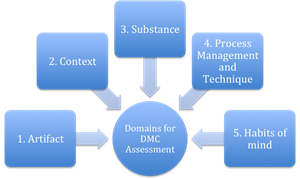 As digital technologies become more available in classrooms, digital multimodal composition has become a common classroom practice. Digital multimodal composition refers to creating digital texts using various modes such as written language, images, video, voice, audio, and so forth. Digital storytelling, digital book reviews, and digital poems are examples of digital multimodal composition.
As digital technologies become more available in classrooms, digital multimodal composition has become a common classroom practice. Digital multimodal composition refers to creating digital texts using various modes such as written language, images, video, voice, audio, and so forth. Digital storytelling, digital book reviews, and digital poems are examples of digital multimodal composition.
As a researcher and an instructor of a course on digital multimodal composition, I am asked frequently how to evaluate students’ digital multimodal compositions. For example, a fourth-grade elementary school English language arts teacher in my class recently shared that her students enjoyed creating digital book reviews using iPads and seemed very motivated to read the book more carefully. However, she explained her hesitancy to use these practices more frequently because she is less confident in how to assess digital multimodal composition.
In this post, I introduce five research-based domains to consider when evaluating students’ digital multimodal composition. Then, I share several sources of rubrics that can be modified easily to meet your needs.
Domains to consider while assessing students’ digital multimodal compositions
In 2013, 10 teachers and literacy researchers in the Multimodal Assessment Project (MAP) group wrote a book chapter on domains for multimodal writing assessment. As a result of this 18-month collaboration, the MAP group identified five domains that are essential when assessing digital multimodal composition as a performance:
- Artifact is the finished product of digital multimodal composition. A well-created product conveys a coherent message to audiences by using appropriate structure, medium, mode, and technique.
- Context involves the rhetorical and physical surroundings of the artifact. Purposes, audiences, composing environment, and modes are elements to consider around context.
- Substance refers to the quality and significance of content and ideas presented in the digital multimodal composition. The credibility and accuracy of information presented are also important criteria to evaluate the substance of an artifact.
- Process management and technique are related closely to composing skills and processes. To compose a digital multimodal text, students should be able to use not only digital devices such as laptops or tablet PCs but also Web 2.0 tools such as iMovie or MovieMaker. Students also need to manage the entire composing process from planning to publishing.
- Habits of mind refer to students’ behaviors or attitudes that develop over time while they compose digital multimodal texts. Creativity, persistence, risk taking, mindfulness, and engagement are examples of important habits of mind.
To understand fully students’ digital multimodal composition as performance, teachers should assess all five of these domains. However, domains such as context, process management and technique, and habits of mind cannot be assessed through the evaluation of final products. Specifically, context and process management and technique can be assessed through a teacher’s observation of overall composing processes. Changes in students’ habits of mind can be measured by collecting students’ written reflections, conducting a short interview, or asking students to complete a survey that captures affective dimensions of their learning.
Useful rubrics for the evaluation of digital multimodal composition
Rubrics are a common form of performance assessment that can help teachers evaluate and score students’ final products. I share a research-based and modifiable rubric and a comprehensive website you can use to locate easily several other types of rubrics for assessing a variety of digital multimodal texts.
Rebecca Burnett and her colleagues conducted a research study on using a common rubric to evaluate multimodal processes and artifacts. As part of the project, they created a so-called “programmatic rubric” and verified its appropriateness through a case study. The rubric included five categories—rhetorical awareness, stance and support, organization, convention, and design for medium—and defined six different levels of performance. The five categories in the rubric cover artifact, context, and substance domains of a digital multimodal composition so that these categories can be assessed through brief observation of composing processes and careful examination of finished products. There are two major benefits of this rubric. First, definitions of each category and level can be applied to different types of digital multimodal composition. Second, teachers can choose several levels to customize the rubric.
The “Assessment and Rubrics” portion of Kathy Schrock’s Guide to Everything website also provides links to various assessment tools and rubrics. The section on “Multimedia and Apps Rubrics” includes links to rubrics for different genres of digital multimodal composition such as a book trailer, digital story, PechaKucha, podcast, and stop motion. The section on “Web 2.0 Rubrics” presents rubrics related to specific Web 2.0 tools such asAnimoto, Glogster, Twitter, and Wikispaces. You can print out these rubrics to evaluate students’ digital multimodal composition or can create your own electronic version of the rubric using one of the programs listed in the “Rubric Builders and Generators” section. For example, Quick Rubric is a website that lets teachers create and save their own rubric. Overall, the rubrics and assessment tools in this post offer a range of practical solutions to help use more digital multimodal compositions as in-class learning practices.
Sohee Park is currently a doctoral student at the University of Delaware.